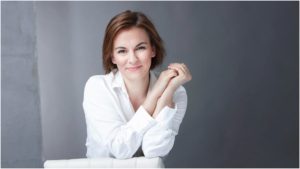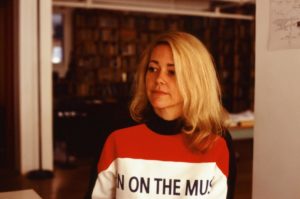
Q & A: Conductor Daniela Candillari Discusses Her Met Debut Conducting ‘Eurydice’ and Her Approach to Score Study
By Jennifer Pyron(Photo credit: Damjan Svarc)
Conductor Daniela Candillari makes her Met Opera podium debut on Wednesday, December 8th, pacing Matthew Aucoin and Sarah Ruhl’s ‘Eurydice.’ OperaWire connects with Candillari to discuss her creative process leading up to ‘Eurydice’ and how she constructs her perspective.
OperaWire: What moments in Aucoin’s work do you enjoy most and how do they resonate with you?
Daniela Candillari: Working with everyone on this team and working closely with Yannick Nézet-Séguin has been an incredibly informative and building experience. ‘Eurydice’ is the second piece by Matthew Aucoin that I’ve worked on. In it, I find there are elements of American minimalism and motives connected to twelve-tone present throughout. There is also a recurring cyclical part of this piece that we first hear during Father’s first aria. It’s a figure of fourths that sounds as if they are rotating, and I find on a larger scale this motive connects the beginning of the opera with almost the very end of it.
The three characters, the Stones, serve as dramaturgical commentators in the plot and their music is unique in that they have a specific harmonic structure that is present in their vocal lines. In the whole piece, I find there is this harmonic expansion that in its core happens from harmonies sometimes being imposed to each other by a half step.
OW: Did you take a philosophical approach towards learning this whole opera? Often there are moments of abstraction happening in the music that make me wonder how a conductor prepares to best express them. What are your thoughts on the piece in this way?
DC: When preparing any score, I start with a broad picture, and then start paring things down to fragments and smaller moments. I like to figure out why music is written the way that it is, what it’s saying, and what connects one phrase to the next one. Even if my decisions change through the process of seeing how the drama develops on stage, it’s these connections that I use to express through my conducting.
In terms of my own philosophical approach when learning this or any piece, my imagination gets really ignited. Sometimes this can be good and sometimes this can be not so great, but I like to find the reason for every single ‘why’ that I might ask myself.
OW: Have there been moments where you shifted your perspective around a certain area of the piece that then took you into a deeper understanding of Aucoin’s composing style?
DC: Yes, this definitely happens and is one of the reasons why I love opera and I love collaborating with stage directors. There is the saying, ‘Every musical note is a dramatic note and every dramatic note is a musical note.’ Sometimes when I feel like the music is telling me one thing, through the process with the stage director, my view can change or expand even more. Maintaining this openness and seeing how a piece can unfold in a different way is incredibly important, and gives me a chance to start building a second layer.
For instance, in the first scene of the opera, there is a certain innocence and playfulness between Orpheus and Eurydice. Shortly after their wedding, the story takes on a completely different turn, as we know. Even though there are comical moments after this, that first opening and those first fifteen or so minutes of music are the only completely innocent part of the drama.
Once I realized that, my reasoning started shifting around this, and I tried to frame the story in my mind and interpretation around that one moment. In this way, the weaving of the dramaturgy has shifted dramatically for me.
OW: How has the stage design and direction for the opera developed since when you first began rehearsals?
DC: On the first day of rehearsals I like the feeling of newness and possibilities, and am always looking forward to participating in a piece being ‘constructed’ by a team. The set is minimal, and it focuses on the story of the relationship between all the characters. For a conductor, I always find that’s a very important question to ask: How do things that we hear in a score connect with what we see on the stage, and how does it influence our perception of sound?
OW: Now that you are back performing and collaborating, have you set a new standard for yourself?
DC: Last year when everything was canceled and all of us found ourselves almost without identity in a way, it was painful, but at the same time, I thought it was a necessary growing process. I ended up asking myself a lot of questions that perhaps in the past I haven’t taken the time to do.
One standard I set for myself was, regardless of what happens, always reminding myself what the most important things are. I think us artists are often guilty of not always being able to take the time for ourselves because being involved with arts is all-consuming.
For me, finding this balance ended up being a bigger understanding, and I wanted to be very honest with myself and know how much I could really do so I can serve the art better.
OW: What have been some of your favorite project experiences this year?
DC: Every project this year has been special for many reasons. I think there is a general sense of excitement about coming back into the rehearsal process and being able to collaborate again in person. The work for me started earlier this year when we did a project with the New York Philharmonic brass section that consisted of six pieces, including one of my arrangements. This was a reorchestration of a piece, titled ‘Sonnet IX,’ written for and premiered by Lincoln Center Trombones a few years ago.
Shortly afterward followed a recording/filming session for Arizona Opera of ‘The Copper Queen’ by Clint Borzoni and John de Los Santos, which just got released. The film was also selected for the Toronto Women International Film Festival and our stage director, Crystal Manich, won an award for the Best First Time Female Director, which we are thrilled about.
Another special project was ‘New Works, Bold Voices’ at the Opera Theater of St. Louis, followed by a concert with the St. Louis Symphony.
I returned to the Music Academy of the West for a concert and a masterclass, and then we recorded ‘Svadba’ by Ana Sokolovic for Boston Lyric Opera, which has been made into a movie and will be released in Winter 2022, and there was a new production of ‘Blue’ at the Michigan Opera Theatre with performances at the Aretha Franklin Amphitheatre.
In October, when I got home to New York City, we started rehearsals for ‘Eurydice.’ It feels like so much has happened over the course of these past six months, which is incredible because I think none of us really knew when and if the arts would come back at this capacity from the pandemic. So every single one of these projects and productions has been really special for a multitude of reasons, be it performing in new venues, reconnecting with colleagues, or returning to some known places.
OW: How have you become aware of yourself as an artist? Can you speak about a moment where you felt you found the spark and sweet spot in your work?
DC: Quite early on in my education, I was introduced to meditation, mainly because I had terrible stage fright. That practice alone has shifted my focus.
In terms of finding the spark in my work, it was really the first time I led a rehearsal. My musical education was widely varied, and I didn’t anticipate that I would ever become a conductor. But a few conductors, who I used to play for, told me I should consider this career, and once I was in the position of leading rehearsals, everything made sense. I guess that was the sweet spot in my work.
Now, in more recent history, during the pandemic, I decided to do a few things that I’ve never done before. One was gardening, the other one was pottery. Both of these offered such different viewpoints and ideas that now I’m always trying to incorporate into my work and my philosophy around the work.
Just being able to participate in the creation of something that we could follow the development of every single day, adjust, reassess, change, was incredibly eye-opening.



